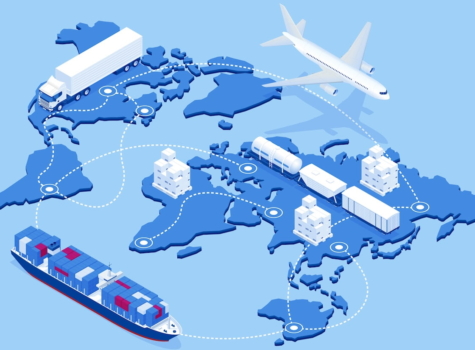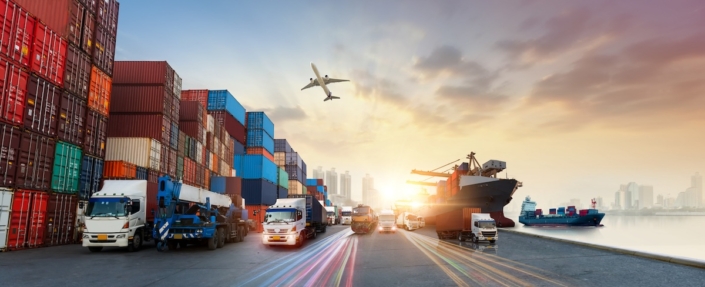International shipping can be incredibly complex, and many ecommerce stores struggle to break into foreign markets. But if you approach things the right way, you’ll be able to reach a wider customer base, increase revenue, and expand your business.
What is international shipping?
International shipping is the process of transporting goods across borders to different countries. Packages can be shipped internationally through various modes of transportation, including sea, air, road, and rail.
Ecommerce international shipping has an obvious—and significant—benefit: It helps you make more sales, reaching customers in previously inaccessible locations. Just a few years ago, there were 9.3 billion cross-border ecommerce orders, and with global trade constantly expanding, now is a great time to find a foothold in other countries.
However, cross-border shipping comes with serious challenges, including higher shipping rates, complicated customs documentation, and longer transit times.
With that said, is it worth it to ship products internationally?
Why shipping internationally is good for business
Despite the challenges mentioned above, research shows that international shipping is the next step for a thriving ecommerce business.
- International ecommerce is expected to increase by 20% annually until 2030.
- Experts estimate that cross-border ecommerce will expand to $1 trillion in merchandise value by 2030.
- International deliveries are growing twice as quickly as domestic ones.
- Thirty-four percent of cross-border shoppers order online at least once a week, and 30% of them increased their online shopping in 2023.
Offering international shipping helps you expand your customer base, and if you provide an excellent shopping and delivery experience, these new customers will become loyal patrons of your store.
Best countries to ship to from the U.S.
Because they have many ecommerce shoppers, the following countries are good ones to ship to from the United States:
- Canda
- United Kingdom
- Australia
- Mexico
- Germany
- France
Mexico and Canada in particular present a great opportunity for parcel shipping because of their physical proximity to the U.S. One study found that 42% of U.S.-based companies ship the majority of their international orders to either Canada or Mexico.
For countries with different primary languages, you’ll need to localize your website to make it accessible to users. See the section “Consider languages and currencies” for some ideas.
Things to consider when shipping internationally
Getting started with ecommerce international shipping? You’ll quickly notice some key differences between domestic and international delivery. Let’s run through the most important ones.
Customs
Customs is the governmental authority that regulates the import and export of goods. Customs administrations enforce regulations, assess duties and taxes, and ensure compliance with trade laws. Since all of your international shipments will pass through customs, it’s important to understand how the process works.
- Step 1: Documentation check. First, customs officers will check to make sure shipments have the required documentation. This can happen remotely before packages have even reached the border.
- Step 2: Package inspection. Next, they make sure you’re not trying to import prohibited or restricted goods, conducting a physical inspection of packages if necessary.
- Step 3: Assessment of duties, taxes, and fees. Before packages can move on, duties, taxes, and fees are calculated.
- Step 4: Decision. Based on the results of the inspection, customs officers will either clear the shipment to continue the delivery process with a carrier, hold it for further inspection, or reject it.
Packages sometimes get held up in customs, but you can take steps to prevent delays. Since one of the most common causes of customs delays is wrong or incomplete documentation, make sure your documentation is accurate before sending out shipments. Additionally, double-check that your products aren’t prohibited or restricted in the country you’re shipping to.
Of course, customs delays can also be caused by issues outside your control. When this happens, proactively communicate with your customers so they understand why their delivery is late.
In the next sections, we’ll dive deeper into the documentation, taxes, duties, and fees associated with customs clearance.
Documentation
When shipping to another country, you’ll need to provide different types of documentation depending on local rules and regulations. This might include the following:
- Commercial invoice. This document includes the description, quantity, value, and weight of the shipped goods and is required for calculating duties and taxes.
- Packing list. A packing list details the contents of each package, including item weights and dimensions.
- Shipping label and tracking number. Packages should be clearly labeled with shipping information and a tracking number for easy identification.
- Certificate of origin. This document indicates the country of origin for the shipped goods—information that’s crucial for assessing duties.
- Bill of lading (BOL) or air waybill (AWB). A BOL for ocean shipments or an AWB for air shipments provides details about the shipment’s journey.
- Customs declaration. A customs declaration form provides details about the contents and value of the shipment for customs clearance.
- Regulatory compliance documents. You might need to provide additional documents—such as permits, certificates, or compliance declarations—to meet specific regulatory requirements.
Looking for a way to automatically create the required customs documentation for your shipments? The EasyPost Shipping API will generate the proper documentation for each shipment and transmit it to the carrier electronically or in paper form.
Taxes, duties, fees
Taxes, duties, and other fees drive up the cost of international shipping. Let’s review some of the extra costs you might incur.
Taxes
Taxes are fixed charges, usually applied as a percentage of an item’s value, that generate revenue for the government. Value-added tax (VAT) and goods and services tax (GST) are consumption taxes applied at each stage of the supply chain based on the “value added” to a product.
Duties
Duties are a tax imposed on goods that are imported or exported, and they vary based on the type, value, and country of origin of the goods.
If a shipment is labeled DDP (delivery duty paid), the duties and taxes have already been paid because you’ve included them in your product pricing and paid them yourself. The alternative option, DDU (delivery duty unpaid), makes the buyer responsible for paying taxes and duties. Choosing DDP streamlines the customs process and improves the customer experience.
Fees
Fees are charges associated with the processing, handling, and movement of goods. They cover services provided by customs authorities, carriers, and others involved in the shipping process. For example, carriers often include surcharges for things like remote delivery, extra handling, and oversized packages. If goods are held in customs storage for an extended period, you may have to pay storage fees.
Learn what taxes, duties, and fees you’re responsible for
Because every country has its own taxes and duties, it can be tricky to figure everything out. In fact, 47% of businesses report that their biggest challenge when shipping internationally is understanding local regulations around duties and taxes.
To learn more about a country’s taxes and duties, you’ll need to do some research. Start by visiting their official customs website, where you’ll find information about the cost of importing goods.
Economic and political status
The economic stability of a country directly influences consumers’ purchasing power, which in turn impacts the demand for certain products. To increase the chances of your international shipping being profitable, focus on countries with well-established, thriving economies.
Additionally, be aware of potential political status changes. Shifts in trade policies, regulations, or geopolitical stability might affect the shipping landscape.
Extreme weather conditions
Extreme weather conditions and natural disasters pose significant challenges when shipping products internationally. Events like hurricanes, earthquakes, and more can result in shipping delays and interruptions across various transportation modes.
These disruptions may lead to increased shipping costs, damage to goods during transit, and communication challenges with customers. To prepare, review your shipping insurance coverage, considering potential exclusions related to extreme weather.
Facing weather-related shipping issues? Promptly inform customers about potential delays to help manage expectations and maintain satisfaction.
Remote locations
Remote locations are far from cities and towns, making them more difficult to access. When you’re just starting, it’s best to restrict your shipping to well-populated areas. Shipping to remote areas can extend transit times and often comes with higher costs due to specialized transportation needs and surcharges.
If you ship to a remote area, provide accurate tracking information and estimated delivery times, and do your best to keep lines of communication open between you, the customer, and the carrier.
Should you use shipping insurance for international deliveries?
Shipping insurance plays an important role in protecting international shipments from loss, damage, and theft. Because packages usually have to travel farther when shipped internationally—and are often transported by various methods—there’s a greater chance they’ll be damaged or lost. And of course, porch piracy is always a risk when shipping to consumers.
Shipping insurance provides a safety net that protects not only your finances but your customers’ peace of mind.
When looking for international shipping insurance, you can choose between a carrier’s insurance offering or a third-party plan. EasyPost offers shipping insurance starting at 5% of a package’s declared value.
What to charge for international shipping
As we’ve discussed, ecommerce international shipping comes with taxes, duties, and fees that drive up costs. Additionally, longer travel distances often require several modes of transportation, including air and sea, which contributes to higher shipping rates. To make international ecommerce shipping profitable, you may need to pass these costs down to your customers.
When setting shipping prices, consider the following factors:
- Packaging materials
- Handling (labor)
- Carrier rates and surcharges
- Duties and taxes
While high shipping costs are hard to avoid, you can improve the customer experience by framing things the right way.
For example, you might decide to include shipping costs in the total product price to give the illusion of free shipping. Doing so can increase your brand’s appeal, as 44% of cross-border shoppers strongly agree that free shipping will become more important in their online shopping.
Whatever pricing strategy you decide on, be transparent about shipping fees throughout the shopping and checkout process so you don’t take shoppers by surprise.
Take a deeper dive into international shipping costs in this article: How To Save on International Shipping Costs.
First steps to begin international shipping for ecommerce
Let’s review some practical tips and strategies to get started with international shipping. If you follow these foundational steps, you’ll find that the way is clear for you to turn international shipping into a booming segment of your business.
Start small, then scale up
If you’ve never shipped to another country before, don’t open up deliveries to many different international locations at once.
Instead, start small. Choose a country that’s relatively close to the U.S. or that shares many commonalities. This will help you market your products, communicate with customers, and get order fulfillment figured out.
Similarly, it’s best to begin offering international shipping for just a few products before expanding your offering. When choosing which products to ship internationally, keep in mind that small, lightweight items will cost less to ship, and high-value items will bring in the most revenue.
Base your strategy on demand
Starting with countries close to home—and high-value, lightweight products—is a good best practice to follow. But you’ll increase your chances of success if you base your international ecommerce strategy on research.
Learn more about the country you plan to begin shipping to. Is there a market for your products there? Depending on the culture, consumer preferences, and trends, you may find that the type of product you sell isn’t in high demand. One survey discovered that the majority of companies that don’t ship internationally report that it’s because there’s no market for their products overseas. (It may be helpful to know that the three leading categories for cross-border commerce in 2022 were clothing and footwear, consumer electronics, and personal care/beauty.)
One simple—and free—way to get a sense of demand is to look at your website traffic analytics. Do you get lots of visitors from other countries? Do any locations stand out? This could be a sign that the people there are interested in what you offer.
Consider languages and currencies
Clear and accurate communication is essential for providing a positive customer experience—and language barriers cause lots of friction. If your website only has an English version, how will French-speaking shoppers understand product information, order details, and customer support messages?
To avoid misunderstandings and convert international visitors, your site should support the major language(s) of each country you ship to. But offering multiple languages is just part of what you need to do. To attract and engage international consumers, localize your site by personalizing it for different countries and cultures. In addition to changing the language on your pages, you might also change the domain name, imagery, currency, and pricing.
Which brings up the next point: currency and payment. The tips below will help you start thinking about how to handle international payments.
- Display pricing in local currency. International browsers should see pricing in their own currency from the beginning of the shopping experience, not just once they enter the checkout page.
- Adjust pricing. Adjusting pricing can be trickier than it sounds! The simplest way is to use exchange rates, but exchange rates always fluctuate, and the ongoing changes will sometimes work in the buyer’s favor and sometimes in the seller’s. As an alternative, you might price products differently for each currency you accept. This requires more maintenance, but it makes the buying experience more predictable for customers.
- Provide different payment options. Each country has its own most popular payment methods. To cater to international shoppers, provide a variety of payment options, such as credit and debit cards, digital wallets, and more.
- Prepare customers for extra fees. Banks usually charge a foreign transaction fee. To avoid confusing customers, include a disclaimer explaining why they’re seeing the fee.
Country rules and regulations
Countries have different rules and regulations about what you can import, including their own lists of prohibited and restricted materials. For example, lithium batteries are often highly regulated because they’re flammable. Other materials, such as plants, alcohol, and food, are also likely to face issues at customs.
To check whether a product is prohibited or restricted, check the country’s official government website.
Package things properly
After delivery speed, damage to packages is the most common consumer complaint about international shipments. When shipped across borders (and often oceans), packages have a long way to travel, so there’s a higher chance they’ll get damaged by rough handling or the elements.
To avoid complaints about package damage, follow these best practices:
- Use strong, sturdy outer packaging
- Choose boxes that aren’t too large or too small
- Include filler materials to cushion fragile items
- Seal packages tightly with tape
Include a disclaimer in your shopping and checkout pages
Odds are, your terms and conditions will be different for international shipments to account for shipping costs, delivery times, product prices, and other factors.
Most shoppers realize that when buying something from another country, they’ll need to pay a little more and wait a little longer for it. However, to provide the best experience, you should still be transparent about your policies.
To decrease cart and checkout abandonment, highlight this information on policy pages:
- Which countries you do and don’t ship to internationally
- Extra fees, including shipping costs
- Expected delivery time frame
- Required documentation
- Returns information (including restrictions)
The cheapest way to ship internationally
To find the cheapest methods of international shipping, compare the rates and delivery times of different carriers based on your shipment details (shipping software helps with this). You’ll probably find that using a combination of carriers is most cost-effective.
If you’d rather not deal with the details, consider working with a parcel consolidation company that combines multiple small shipments into one larger one. Consolidators handle customs documentation and can access bulk discounts on shipping, which they pass on to your business.
Finally, remember that the cheapest option isn’t always the best one. Instead of trying to cut corners, prioritize the safety, security, and speed of your shipments. By spending a little extra on reliable carriers and investing in shipping insurance, you’ll save money in the long run.
Choosing the right international shipping carrier
When choosing an international shipping carrier, consider things like cost, delivery speed, tracking, surcharges, and additional value-added services.
The following carriers are known for their quick, reliable international shipping:
- DHL (DHL Express or DHL eCommerce)
- USPS
- UPS
- FedEx
For a detailed breakdown of the pros and cons of each one, check out this article.
Effortless ecommerce international shipping
Many businesses hesitate to begin shipping internationally because it’s complex and expensive. EasyPost helps solve both issues. The Shipping API gives ecommerce businesses access to discounted rates from both domestic and international carriers, streamlines the label creation process, and provides customs documentation. You can also add insurance to your shipments for a fraction of what carriers charge.
Sign up for free to get started.
(Already using EasyPost? Check out this guide to learn how to begin shipping internationally through the API.)




